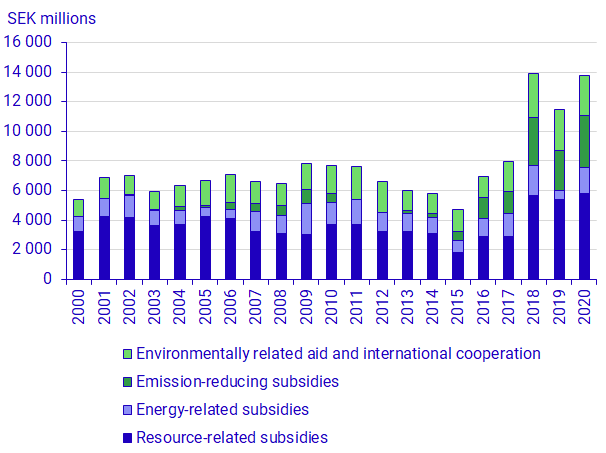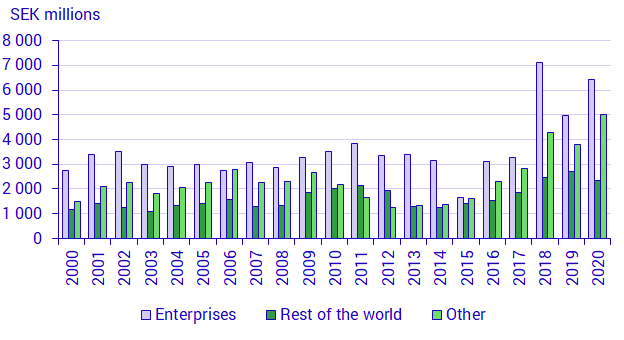Environmentally motivated subsidies 2020. Corrected 2021-05-26
Environmentally-motivated subsidies increased in 2020
Statistical news from Statistics Sweden 2021-05-18 9.30
Environmentally-motivated subsidies, covering transactions contributing to reduced climate and other environmental impacts as well as more efficient natural resource use, increased in 2020 compared to 2019.
Environmentally-motivated subsidies totalled 13.8 billion Swedish krona in 2020. This is an increase of 20 percent compared to 2019. Subsidies cover four areas: emissions reduction, energy, environmental aid and international co-operation, and natural resources.
The increase in 2020 arose principally due to increased payments for energy, from 0.6 to 1.8 billion Swedish krona. Solar cells, biogas and energy storage accounts for the largest increase.

The largest environmental subsidies are in natural resources at almost 5.8 billion Swedish krona in 2020. Environmental improvement measures in agriculture constitute the largest part of natural resources subsidies and have also increased over the time series of the statistics. These include environmental benefits to farmers through the Swedish rural development program, e.g. biodiversity measures in the farmed landscape and environmentally friendly agriculture. EU greening support is included in the statistics since reference year 2015.
Environmental subsidies go primarily to companies
The subsidies, that is payments for investment and consumption, can go to different stakeholders nationally and internationally. Swedish companies, non-profits, households and other public authorities in Sweden are recipients of about 83 percent of the total. The remainder go to international organisations and aid. Subsidies to domestic stakeholders were 11.4 billion Swedish krona in 2020, a 30 percent increase compared to 2019. Subsidies to international organisations and aid were 2.3 billion Swedish krona in 2020, a 13 percent decrease compared to 2019.

Others includes households, public sector and non-profit institutions serving households
Definitions and explanations
Environmentally motivated subsidies are defined in accordance with the SEEA Central Framework statistical standards for environmental accounts. The definition that applies in Statistics Sweden’s environmental accounts is informed by the subsidy objective. Therefore, the definition used in the environmental accounts is broader than the one used in the national accounts, as the environmental accounts also include capital and current transfers and social benefits in kind.
For the environmental accounts, the primary source for the subsidy objective has been the Government’s Budget Bills for various years. These statistics are derived from the National Financial Management Authority’s calculations of the central government budget’s outcome, in which transactions are traced back to the government appropriations from which they came. In 2015, Statistics Sweden carried out a development project that reviewed the methodology of the statistics.
Statistics Sweden has published statistics on environmentally motivated subsidies since 2000.
Next publishing will be
June 2022
Feel free to use the facts from this statistical news but remember to state Source: Statistics Sweden.
